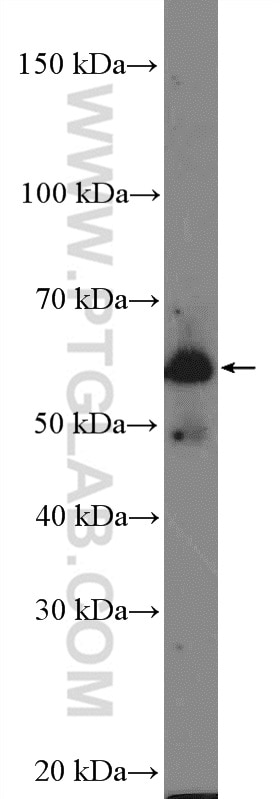Tested Applications
| Positive WB detected in | human testis tissue |
Recommended dilution
| Application | Dilution |
|---|---|
| Western Blot (WB) | WB : 1:500-1:1000 |
| It is recommended that this reagent should be titrated in each testing system to obtain optimal results. | |
| Sample-dependent, Check data in validation data gallery. | |
Published Applications
| IF | See 2 publications below |
Product Information
25861-1-AP targets SPATC1 in WB, IF, ELISA applications and shows reactivity with human, mouse samples.
| Tested Reactivity | human, mouse |
| Cited Reactivity | mouse |
| Host / Isotype | Rabbit / IgG |
| Class | Polyclonal |
| Type | Antibody |
| Immunogen |
CatNo: Ag12157 Product name: Recombinant human SPATC1 protein Source: e coli.-derived, PET28a Tag: 6*His Domain: 1-350 aa of BC053547 Sequence: MALAPLAEMLTSLQPSATPGSLMSPLTGTLSTLLSGPAPTSQSSPLTSFLTSPIAGPLTGTLASSLGLPSTGTLTPSSLVAGPVAMSQSSPLIAPVMGTVAVSLSSPLLSSTATPPGVSQNLLANPMSNLVLPEAPRLRLAEPLRGGPTGPQSPACVVPTATTKVPLSTEPPQSTQDPEPLSMAFAGAPLQTSTPIGAMGTPAPKTAFSFNTSDTQAQPSAAQEQVVPASVPTSPTTSPTVTVLASAPALAPQVATSYTPSSTTHIAQGAPHPPSRMHNSPTQNLPVPHCPPHNAHSPPRTSSSPASVNDSRGPRTTEPSTKSMMEVERKLAHRKTSKFPENPRESKQLA Predict reactive species |
| Full Name | spermatogenesis and centriole associated 1 |
| Calculated Molecular Weight | 500 aa, 52 kDa |
| Observed Molecular Weight | 60 kDa |
| GenBank Accession Number | BC053547 |
| Gene Symbol | SPATC1 |
| Gene ID (NCBI) | 375686 |
| RRID | AB_2880273 |
| Conjugate | Unconjugated |
| Form | Liquid |
| Purification Method | Antigen affinity purification |
| UNIPROT ID | Q76KD6 |
| Storage Buffer | PBS with 0.02% sodium azide and 50% glycerol, pH 7.3. |
| Storage Conditions | Store at -20°C. Stable for one year after shipment. Aliquoting is unnecessary for -20oC storage. 20ul sizes contain 0.1% BSA. |
Protocols
| Product Specific Protocols | |
|---|---|
| WB protocol for SPATC1 antibody 25861-1-AP | Download protocol |
| Standard Protocols | |
|---|---|
| Click here to view our Standard Protocols |
Publications
| Species | Application | Title |
|---|---|---|
Mol Cell Proteomics Modification of Crocodile Spermatozoa Refutes the Tenet That Post-testicular Sperm Maturation Is Restricted To Mammals | ||
Mol Cell Proteomics Proteomic profiling of crocodile spermatozoa refutes the tenet that post-testicular maturation is restricted to mammals. |




